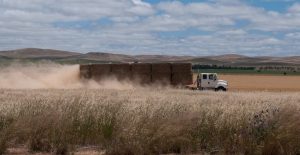
Did you get a CVD with that load of hay?
PRODUCERS feeding sheep, lambs and other livestock with bought-in fodder and grain have been urged to seek a commodity vendor declaration where possible.
Integrity Systems Company chief executive officer Dr Jane Weatherley said the CVD is an important tool in safeguarding animals’ feed supply and meeting requirements for product integrity.
“The CVD is a key document within the overarching integrity system that contributes to the quality assurance and safety of Australian red meat.
“With the tough weather conditions in many parts of the country, producers are buying in a large amount of feed, so it’s important to maintain our commitment to premium markets by keeping the records necessary for verifying product integrity,” Dr Weatherley said.
Under the Livestock Production Assurance, red meat producers must keep accurate livestock feeding records. This is detailed in element three of LPA, ‘Fodder crop, grain and pasture treatments and stock foods’. Part of this requires producers to take responsibility for all introduced feedstuffs given to their cattle, sheep or goats.
“Any producer who obtains fodder or grain from a third party can ensure they know exactly what is being fed to their livestock by having its supplier complete a CVD.
“A CVD is also good for helping to manage on-farm biosecurity risks such as introducing pests and weeds from purchased fodder,” Dr Weatherley said.
“Biosecurity planning is also a requirement of the LPA program as part of changes that came into effect from 1 October 2017.”
The CVD is a single-page form which collates accurate details of the commodity’s composition, including any chemical treatments applied to it during growth and/or processing.
The CVD provides information on the feedstuff’s origin (either from a single source or via multi-vendor storage, such as when it has passed through a grain depot, cotton gin or seed storage site). It also records any contamination with restricted animal material (such as meat and bone meal) and/or the presence of genetically modified organisms.
“The CVD is a legal document and should be signed by either the commodity’s supplier or the person responsible for its production/storage immediately before its dispatch to the buyer,” Dr Weatherley said.
Dr Weatherley said LPA-accredited producers were strongly urged to source stockfeed only from suppliers who were willing to vouch for its content by providing an accompanying CVD. Completed CVDs should be filed alongside other farm records.
The CVD can be downloaded electronically as a single PDF from the MLA website. To assist both suppliers and red meat producers, a page of explanatory notes is provided with the blank CVD. Producers seeking more information about CVDs can call the LPA Helpline 1800 683 111 or email [email protected]

This is a great reminder article. But can Dr Weatherley elaborate on what producers can do where CVDs aren’t possible, such as is the case often with feeds such as cottonseed meal? Especially as it is getting to the point producers aren’t just outsourcing feed supplies; they are desperate to be able to get their hands on anything, with the price rapidly increasing due to supply and demand and with some feed supply stores even limiting the number of hay bales producers can purchase.